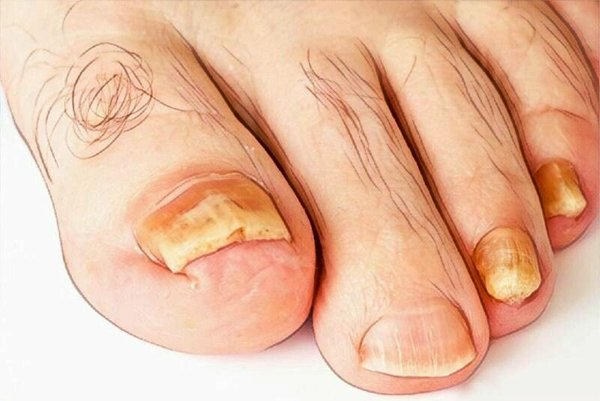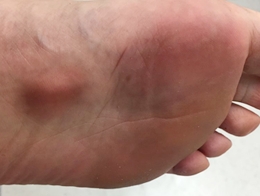Thick Toenails
Why are your toenails thick? Get more insights on how to get rid of your thick, unattractive toenails and find out the various causes, treatment and home remedies to trim your thick yellowish toenails.
Toenails do more than just adorning your feet
Yes, you read it right! Toenails are not vestigial and they have more functions than just making your feet look beautiful. Toenails help you in balancing while walking or dancing by providing counter-pressure. Toenails also protect the tip of your toe bones to some extent. Moreover, changes in the appearance of toenails may be indicative of certain diseases. For instance, pitty or scaly toenails may occur as a symptom of connective tissue disorder.
Causes of Thick Toenails
Your toenails may sometimes become thick and difficult to trim. Toenails become thick due to variations in the nail bed, plate and root. The changes may be temporary or permanent depending on the severity of the cause. Most of the times, thick toenails are caused due to fungal infection and getting rid of the fungal infection may be an arduous task.
Fungus
Fungal toenail infection, medically termed as Onychomycosis, is associated with pain and may sometimes cause disfigurement of the toenails. However, pain and disfigurement appear as the disease progresses. In the initial stages, thick toenails due to fungal infection may appear only as a cosmetic concern. Albeit, as the thickness of the toenail increases, it starts pressing against the inside of the shoes, thereby causing a lot of pain and discomfort. Eventually, onychomycosis may lead to loss of dexterity, thus causing serious physical and occupational limitations.
Thick toenails due to fungal infection are characterized by brittle nails with yellowish discoloration, which may gradually turn into green or black color.
Thickening of the toenail due to fungal infection is more common in immunocompromised people. It occurs more in the elderly population as compared to younger people. Advanced form of fungal infection, called dystrophic onychomycosis, may cause permanent damage to the toenails. Fungal toenail infection may be contagious. Therefore, care should be taken to avoid sharing footwear with people suffering from thick toenails.
Candida albicans
Sometimes, a yeast known as Candida albicans may also cause thickening of your toenails. Along with thick toenails, candida infection presents additional symptoms like inflammation of the nail fold and separation of the nail from the nail bed. Some of these fungal infections may also be a source of a foul cheesy odour emanating out of your toenails.
Thick toenails caused due to fungal infections can be easily identified by the appearance. However, confirmatory lab tests should be carried out before commencement of treatment in order to avoid misdiagnosis of some other medical condition such as this.
Trauma of the nail
Apart from the infection caused by fungus, thick toenails can be caused due to trauma to the nail. Thickening of nails due to trauma, medically known as Onychauxis, may occur as a result of dropping something heavy, like a hammer, on your toe or wearing poorly fitted shoes. Thick toenails occurring due to trauma can be identified by presence of cuts or bumps around the toenail. Generally, trauma causes thickening of the upper part of your toenails. Your nails may turn yellow or white in color and may start falling apart from the edges.
Certain medical conditions like acromegaly, Darier’s disease or Pityriasis Rubra Pilaris may also cause onychauxis.
Hereditary
Another factor responsible for thickening of toenails is heredity. A person whose mother or father has thick toenails may face a similar issue at some point in his life.
Poor circulation of blood
Toenails require adequate blood supply to appear healthy and grow properly. Any medical condition which hinders the blood supply to the lower extremities may cause the toenails to thicken. For instance, thick toenails are often observed in people suffering from psoriasis and diabetes, in which blood supply to the lower extremities is poor.
Ageing
Thick toenails may also occur as a result of the natural process of ageing. As the age increases, the blood flow to the lower body diminishes, thereby giving rise to thick toenails.
Thick Toenails Treatment
So, I want to get rid of my thick toenails, how do I treat them?
Antifungal Medication
Thick toenails may often be difficult to treat. If the thick toenails are caused due to fungal infection, cutting your toenails may be cumbersome as the toenails may be very brittle and may crack in the middle. The doctor may prescribe oral or topical antifungal medicines to treat the fungal infection. The effectiveness of topical antifungal agent may be less due to its limitations in penetrating into the deeper parts of the nail. The oral antifungal medicines are very effective but they may affect the functioning of the liver. A combination of oral and topical antifungal agent may however be useful and may help in reducing the severity of the side effects caused by oral antifungal medicines. Even after complete treatment of thick toenails due to fungal infections, the rate of recurrence is high.
Surgery
Recently, surgical and laser intervention for removal of fungal infection from toenails are available. Surgical procedures like nail avulsion or matrixectomy make use of chemicals to remove the thick toenails using a urea compound. Laser treatment makes use of laser beam to penetrate the nail tissue and heat to kill the fungus growing in the toenails. Laser treatment is very costly, painful and the success rate is very low. Therefore, surgery and laser treatment should be used only as the last resort to cure thick toenails due to fungal infections. Moreover, these become ineffective when used alone and need to be combined with oral and topical antifungal agents for best results.
Prevention of thick toenails
You can prevent occurrence of thick toenails due to fungal infection by following a few precautionary measures. Firstly, avoid sharing footwear and socks with other people. Secondly, do not go barefoot into public showers and bathrooms. Thirdly, make sure that instruments used for pedicure are appropriately sterilized. Keep your toenails trimmed and wear synthetic socks that will absorb your sweat(especially while running). Dusting some antifungal powder in your gym and sports shoe may help keeping fungal infections away from your toenails.
Treating Onychauxis
Onychauxis can be treated by trimming the nails regularly. Most importantly, treatment of onychauxis involves finding out the root cause behind the condition. If you are suffering from thick toenails as a result of underlying medical conditions like psoriasis or diabetes, treating the root cause may improve the appearance of your nails.
Regular workout and exercise can help in improving the blood flow to the lower limbs, thereby reducing the risk of formation of thick toenails due to insufficient blood supply. In extreme cases, complete or partial removal of the affected toenail may be required.
Home Remedies
- Various home remedies like soaking your feet in hot water containing antibacterial mouthwash/ soap/ epsom salt or vinegar may prove to be useful in treating thick toenails.
- Dry your feet immediately after cleaning as moisture promotes the growth of fungus.
- Applying tea tree oil, vicks vaporub or orange oil directly to the toenails have also been reported to be effective in treating thick toenails, however the efficacy of these home remedies is not clinically proven.
- Use of comfortable shoes with ample space for toes help in reducing the development of thick toenails caused due to trauma. Always tie your shoelaces tightly so as to prevent your foot from sliding to the front.
Thick or brittle toenails may sometimes occur as a result of nutritional deficiencies. Dietary modifications may also help in prevention of thick toenails. Incorporating vitamin C- rich food like cabbage, oranges, grapes and cauliflower in your daily diet may help improve the appearance of nails.
Trimming of Thick Toenails
How can I make trimming thick toenails a less painful affair?
Cutting a thick toenail may be very painful and inconvenient. Moreover, there is a possibility that the infection due to onychomycosis may spread to other parts of the toe. Diabetes is known to delay wound- healing process. Therefore, people suffering from diabetes should take care to prevent injury while trimming toenails.
However, trimming the toenails from time to time makes the nails look clean. Most of the times, nail cutter alone may not be of much use for cutting thick toenails. Using a nail file along with the nail cutter may help in reducing the thickness of your toenail. Sterilize the nail file and nail cutter every time before and after use.
Soaking your feet in warm water for 10 – 15 minutes before cutting your nails helps in softening the nails. Applying moisturizer to your toenails also helps in softening them, thereby making it easier and less painful to cut the toenails. Care should be taken to avoid excessive softening of the toenails so as to avoid injury to the nail bed while cutting.
Cutting the toenail in straight line is advisable in order to prevent development of ingrown nails. Selection of the right tool for trimming the toenail is absolutely essential. A heavy duty toenail clipper may be required to trim extremely thick toenails. An emery blade may be used to smoothen the rough edges of the toenail. However, if the thick toenails become difficult to cut and cause a great deal of pain and sometimes bleed, it is advisable to visit a podiatrist or a physician immediately.
Thick Toenails Pictures
Have a look at some of the pictures of thick toenails
Thick toenails affecting the big toe
Thick yellowish toenails








